كل مشروع له أصحاب مصلحة، والطريقة التي تبني بها علاقاتك مع هؤلاء الأشخاص هي التي يمكن أن تنجح مشروعك أو تفسده. تساعد العلاقات القوية على بناء الثقة وتمكين فريقك من استخدام خبراتهم للوصول إلى أهداف مشروعك، في حين أن العلاقات الضعيفة يمكن أن تؤدي إلى الصراع وعدم رضا العملاء.
تتطلب إدارة العلاقات مع أصحاب المصلحة الوقت والجهد والنية. اجعل التجربة بأكملها أكثر سلاسة بمساعدة خطة إدارة أصحاب المصلحة.
في هذا الدليل، سنغطي أساسيات إدارة أصحاب المصلحة، وسبب أهميتها، وكيفية إنشاء خطة إدارة أصحاب المصلحة الخاصة بك.
دعنا نتعمق في الأمر.
ما هي إدارة أصحاب المصلحة في إدارة المشاريع؟

استخدم ClickUp Whiteboards لتعيين المهام، ووضع علامات على أصحاب المصلحة كمكلفين، وأي شيء مطلوب لبدء تعاونك التالي
أصحاب المصلحة هم الأشخاص الذين تعمل معهم (أو من أجلهم) أثناء المشروع. إنهم الأشخاص الذين يعتبرون جزءًا لا يتجزأ من نجاح المشروع والذين يجب إطلاعهم على تقدم المشروع طوال الوقت.
إدارة أصحاب المصلحة هي فن وعملية بناء علاقة جيدة مع هؤلاء الأشخاص والحفاظ عليها طوال فترة المشروع حتى تتمكن من تحقيق أفضل نتائج المشروع. 🏆
لا تقتصر إدارة أصحاب المصلحة في المشروع على مجرد إعداد قائمة بكل من له علاقة بمشروعك. إنها عملية تتضمن تصنيف أصحاب المصلحة وتحديد أولوياتهم، بالإضافة إلى تصميم الطريقة التي تتواصل بها مع كل صاحب مصلحة.
والغرض من ذلك هو خلق تجربة سلسة وفعالة وفعالة لأصحاب المصلحة في المشروع.
أنواع أصحاب المصلحة
ما هو صاحب المصلحة في إدارة المشروع؟ عندما نفكر في أصحاب المصلحة الرئيسيين، فإننا غالبًا ما نفكر في العميل الرئيسي وأي مستفيدين آخرين - ولكن في الواقع، فإن قائمة أصحاب المصلحة في المشروع يمتد إلى ما هو أبعد من ذلك.
صاحب المصلحة هو أي شخص يتأثر بشكل مباشر أو غير مباشر بمشروعك وأي شخص لديه مصلحة كبيرة في نجاحه - مثل مستثمر أو وكالة حكومية. وهذا يعني أنه يمكن أن يكون لديك أصحاب مصلحة داخليين وخارجيين في خطة إدارة مشروعك.
غالبًا ما يكون أصحاب المصلحة مؤثرين ولديهم سلطة اتخاذ القرار أو مصلحة مالية في المشروع، كما أنهم يتناسبون مع دور فريد داخل فريق المشروع - مثل العميل الرئيسي أو شريك أساسي. 🤝
تشمل الأنواع الأكثر شيوعًا من أصحاب المصلحة في المشروع ما يلي:
- العملاء
- الاستشاريون
- الوكالات الحكومية
- رعاة المشروع
- المستثمرون
- الممثلون المنتخبون
- أعضاء مجلس الإدارة والمديرين التنفيذيين
- مالكو الأراضي أو الموارد
- البائعون والموردون (راجع هذهقوالب قائمة البائعين)
- المقاولون والمقاولون من الباطن
- أعضاء فريق المشروع
- المستخدمون النهائيون
- أعضاء المجتمع
هذه القائمة ليست شاملة. قد تجد أن هناك في مشروعك أصحاب مصلحة داخليين يشغلون أدواراً أخرى أو لديهم مسؤوليات فريدة من نوعها. في بداية المشروع، خذ وقتك في تحديد أصحاب المصلحة من كل زاوية، مع الحرص على عدم إغفال أي شخص.
لماذا تعتبر إدارة أصحاب المصلحة مهمة؟
غالبًا ما يكون للمشاريع الكثير من أصحاب المصلحة الداخليين والخارجيين، وسرعان ما يصبح تتبع الجميع وكل ما يجري في المشروع نفسه تحديًا دون وجود طريقة جيدة لإدارة كل ذلك.
تعد إدارة أصحاب المصلحة أمرًا ضروريًا، مما يتيح لك التنظيم وتحديد أولويات أصحاب المصلحة ومنح مشروعك أفضل فرصة للنجاح. تساعدك الإدارة الفعالة لأصحاب المصلحة على:
- تحديد أصحاب المصلحة الرئيسيين وتحديد الأولويات
- بناء علاقات قوية وقائمة على الثقة من أجل المشاركة الفعالة لأصحاب المصلحة
- تكييف نهجك ليتناسب مع احتياجات كل صاحب مصلحة
- التعامل مع العوائق بأقل تأثير ممكن
- التواصل بفعالية مع كل طرف طوال فترة المشروع
- حافظ على مشاركة أصحاب المصلحة طوال دورة حياة المشروع
- اجعلتنفيذ المشروع أسهل لجميع أصحاب المصلحة المعنيين
- العمل معًا بشكل أفضل لتحقيق أهدافك الاستراتيجية ومخرجات المشروع للأسباب المذكورة أعلاه وأكثر، فإن إدارة أصحاب المصلحة بشكل فعال أمر بالغ الأهمية لنجاح المشروع. فبدون وجود عملية إدارة أصحاب المصلحة في مكانها الصحيح، يكاد يكون من المستحيل إبقاء الأشخاص المناسبين على اطلاع دائم بالتفاصيل الصحيحة في الوقت المناسب.
وأفضل طريقة لتحقيق ذلك هي وضع خطة استراتيجية لإدارة أصحاب المصلحة. 📄
كيفية إنشاء خطة إدارة أصحاب المصلحة ## كيفية إنشاء خطة إدارة أصحاب المصلحة
تمنحك الخطة الاستراتيجية الجيدة لإدارة أصحاب المصلحة إطار العمل الذي تحتاجه لإدارة أصحاب المصلحة بأكثر الطرق فعالية. فيما يلي عملية من سبع خطوات لكيفية إنشاء خطة استراتيجية خاصة بك حتى تتمكن من العمل بشكل أوثق مع أصحاب المصلحة وإبقائهم متفاعلين مع ما تعمل عليه.
1. تحديد أصحاب المصلحة
قبل أن تتمكن من إشراك أصحاب المصلحة، عليك أولاً معرفة من هم أصحاب المصلحة. الخطوة الأولى في أي خطة ناجحة هي تحديد أصحاب المصلحة الخارجيين أو الداخليين. 🕵️
فكّر في نطاق المشروع وأهداف المشروع، وتدوين أي شخص يتبادر إلى الذهن كأحد أصحاب المصلحة المحتملين. كما يجب على مديري المشروع أن يدرجوا أي مدخل في القائمة أعلاه، بالإضافة إلى أفراد آخرين من الجمهور أو أشخاص أو هيئات مهنية أو شركاء مشاركين في مقاييس نجاح المشروع بشكل عام.
في مرحلة تحديد أصحاب المصلحة، لا يجب أن تكون قائمتك مفصلة للغاية. فمع تقدمك في العملية ستقوم بتصنيف أصحاب المصلحة وترتيبهم حسب الأولوية. الهدف الآن هو ببساطة إعداد قائمة أولية.
2. أنشئ قاعدة بيانات لأصحاب المصلحة لديك
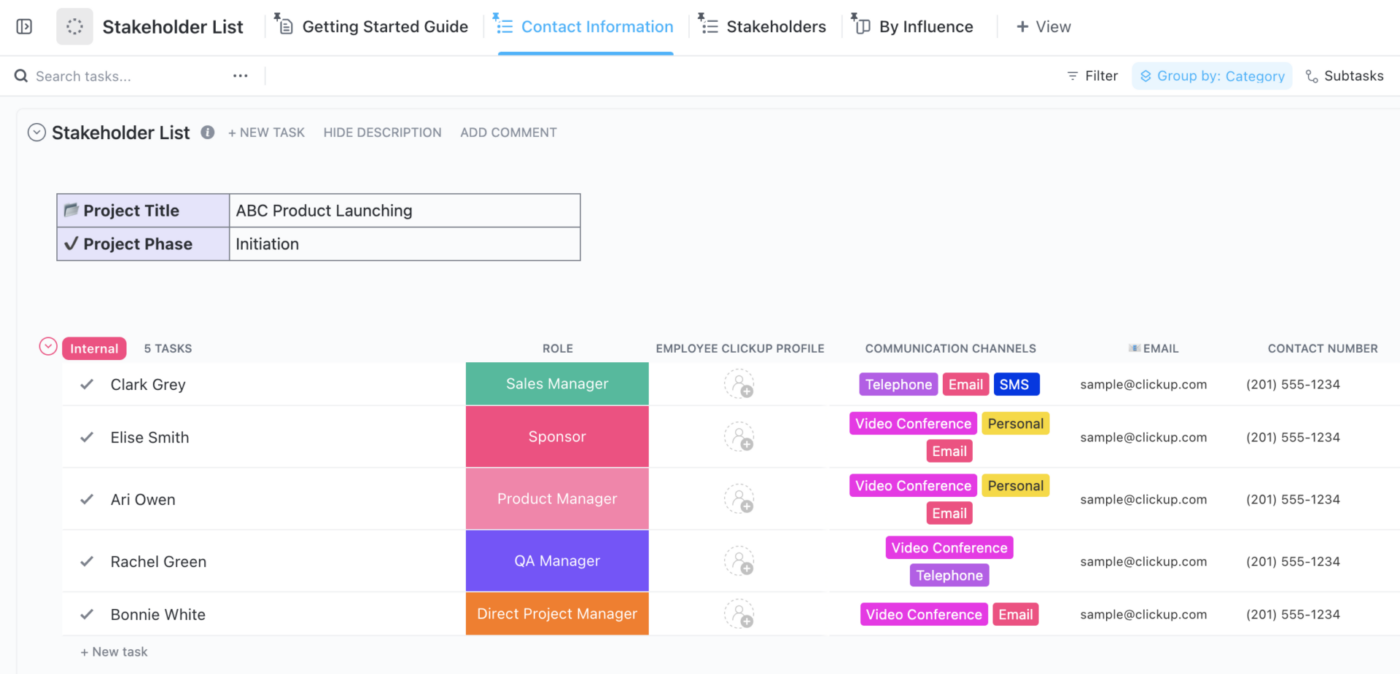
تتبّع أصحاب المصلحة الداخليين والخارجيين في قائمة ClickUp
بمجرد حصولك على قائمة بأصحاب المصلحة في المشروع، يمكنك البدء في تكوين صورة أكثر تفصيلاً عن هويتهم وأدوارهم ومسؤولياتهم. الآن هو الوقت المثالي للبدء في إنشاء قائمة أصحاب المصلحة أو سجل أصحاب المصلحة، بحيث يمكنك استخدامها للتواصل معهم وإشراكهم لاحقاً.
اجمع التفاصيل حول أصحاب المصلحة، بما في ذلك الشركة أو المؤسسة التي يعملون بها، ومسمياتهم الوظيفية، ودورهم في المشروع، وكيفية التواصل معهم، وأي ملاحظات أساسية - مثل العلاقة القائمة أو أي مشاكل معروفة. 📝
استخدم قالب قائمة أصحاب المصلحة من ClickUp لتنظيم معلومات أصحاب المصلحة بطريقة بسيطة ومرئية. يساعدك القالب على التفريق بسهولة بين أصحاب المصلحة الداخليين وأصحاب المصلحة الخارجيين، أو تخصيص التسميات لإنشاء فئاتك الخاصة. اطلع على اسم صاحب المصلحة، ودوره، وقنوات الاتصال، وتفاصيل الاتصال في لمحة سريعة.
هذا القالب مفيد للغاية ليس فقط لتنظيم بياناتك ولكن أيضًا لأعضاء فريقك عندما يحتاجون إلى تحديد مديري المشروع أو قادة المشروع أو الاتصال بهم بسرعة.
3. صنف أصحاب المصلحة وحدد أولوياتهم

استخدم نموذج تحليل أصحاب المصلحة من ClickUp لتتبع جميع أصحاب المصلحة لديك
بينما يجب أن نخلق أفضل تجربة ممكنة لكل أصحاب المصلحة، لا يتساوى جميع أصحاب المصلحة. تتطلب مجموعات أصحاب المصلحة المختلفة أساليب إدارة وتواصل مختلفة قليلاً، لذا فإن تحديد أصحاب المصلحة أمر ضروري.
استخدم عملية تخطيط أصحاب المصلحة لتحديد أهم أصحاب المصلحة لديك. إن قالب تحليل أصحاب المصلحة من ClickUp يساعدك على القيام بذلك بشكل تعاوني من خلال شبكة قوة/اهتمامات سهلة الاستخدام.
ضع جميع أصحاب المصلحة على قالب المصفوفة الشبكة وفقًا لموضعها من حيث مستوى قوتها (أو مستوى تأثيرها) ومستوى اهتمامها. هذا تحليل أصحاب المصلحة ستسمح لك الاستراتيجية بفهم المجموعات التي تحتاج إلى إيلاء اهتمام وثيق لها والمجموعات التي يمكن ببساطة إبقاؤها على اطلاع على التقدم المحرز. 👀
بالنسبة لأصحاب المصلحة ذوي النفوذ والاهتمام العالي (مثل رعاة المشروع والعملاء)، وإدارتهم عن كثب وإبقائهم راضين ومطلعين طوال الوقت. ولكن يمكن أن يساعدك تحليل أصحاب المصلحة أيضًا في العثور على أصحاب المصلحة ذوي الاهتمام المنخفض وأصحاب المصلحة ذوي النفوذ المنخفض (مثل المجموعات المجتمعية أو أفراد الجمهور).
قد يحتاج هؤلاء الأشخاص إلى مستوى أقل من المشاركة ويمكن إبقاؤهم على اطلاع بين الحين والآخر ومراقبتهم بشكل خفيف.
4. وضع خطة تواصل مع أصحاب المصلحة
بعد تحديد أولويات أصحاب المصلحة، ستحتاج بعد ذلك إلى خطة لكيفية التواصل والتفاعل معهم طوال العملية. حان الوقت لوضع خطة تواصل استراتيجية لأصحاب المصلحة.
ضع في اعتبارك كل صاحب مصلحة في مشروعك، وخطط لخطة تواصل مخصصة لكل منهم. يجب أن تغطي خطة التواصل والمشاركة مع أصحاب المصلحة ما يلي:
- أهداف التواصل مع مشروعك أو أهداف إشراك أصحاب المصلحة
- طرق أو قنوات التواصل
- وتيرة التواصل
- الأسلوب والنبرة
- الموارد المطلوبة لتنفيذ خطة التواصل الخاصة بك
- عضو (أعضاء) الفريق المسؤول عن كل مرحلة من مراحل خطة التواصل الخاصة بك
- الرسائل أو مخرجات التواصل المحتملة في مختلف مراحل خطة التواصل الخاصة بك
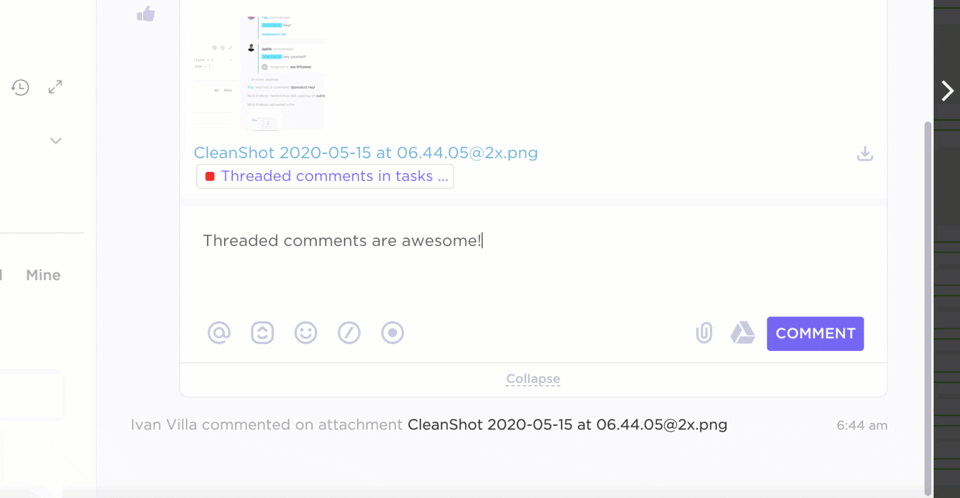
تواصل مع فريقك مباشرة في مهمة ومشاركة المهام الأخرى وتحميل الملفات مع التعليقات المترابطة في ClickUp!
في خطة عمل التواصل الخاصة بك، قد تحدد أنه بالنسبة لعميلك ستوفر اتصالات أسبوعية من خلال سلاك أو البريد الإلكتروني أو من خلال اجتماعات المشروع المنتظمة. بالنسبة لأعضاء المجتمع، يمكنك إرسال تحديث شهري أو ربع سنوي للمشروع عبر البريد الإلكتروني. 📧
قد يبدو وضع خطة مصممة خصيصاً لكل مجموعة من أصحاب المصلحة أمراً مربكاً في البداية، لكن تخصيص الوقت والجهد في البداية يجعل من السهل الحفاظ على المساءلة والاتساق طوال دورة حياة المشروع بأكملها.
5. تخصيص الموارد لخطتك
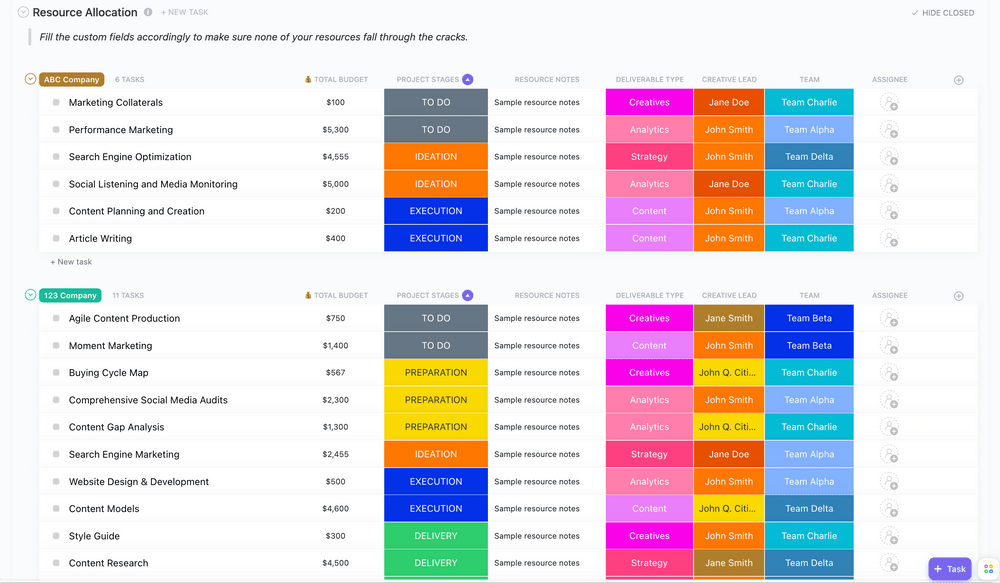
استخدم قالب ClickUp تخصيص الموارد قالب لتتبع مواد المؤسسة وأعضاء الفريق وغير ذلك لكل مشروع
إن وجود خطة أمر رائع، لكنك تحتاج أيضًا إلى الموارد المناسبة للسماح لك بتنفيذها فعليًا. فكر في الموارد التي تحتاجها، ثم خصصها لـ خطة المشروع وأعضاء الفريق وفقًا لذلك.
ستتطلب بعض عناصر خطة التواصل مع أصحاب المصلحة موارد أكثر من غيرها، ولكنك ستحتاج دائماً إلى وقت وطاقة أعضاء الفريق لتحقيق ذلك. وتشمل الموارد المحتملة الأخرى ميزانية لأدوات التواصل والتصميم، والمواد المطبوعة، والفعاليات الصحفية، والتصوير الفوتوغرافي الترويجي، وغير ذلك. 📷
إذا كنت تستخدم ClickUp بالفعل أو كنت تفكر في اتخاذ خطوة، فهناك الكثير من النماذج لمساعدتك في إدارة الموارد. استخدم قالب تخصيص الموارد من ClickUp لتنظيم طلبات الموارد والحصول على نظرة عامة واضحة لأي موارد متفق عليها ومخصصة.
6. شارك خطتك مع أصحاب المصلحة
بمجرد أن تكون راضيًا عن خطة المشاركة الخاصة بك ومتأكدًا من أنها واقعية، فقد حان الوقت لمشاركتها مع أصحاب المصلحة. قد لا تبدو هذه الخطوة واضحة، لكنها خطوة يمكن أن تساعد بشكل كبير في إدارة توقعات أصحاب المصلحة.
شارك خطتك خطة التواصل لتحسين مشاركة أصحاب المصلحة لمساعدتهم على فهم العملية، وجدولك الزمني للاتصالات، وما يمكن أن يتوقعوا رؤيته. فكر في خطتك كخارطة طريق لكيفية بقاء مديري المشروع على اتصال مع بعضهم البعض خلال المشروع.
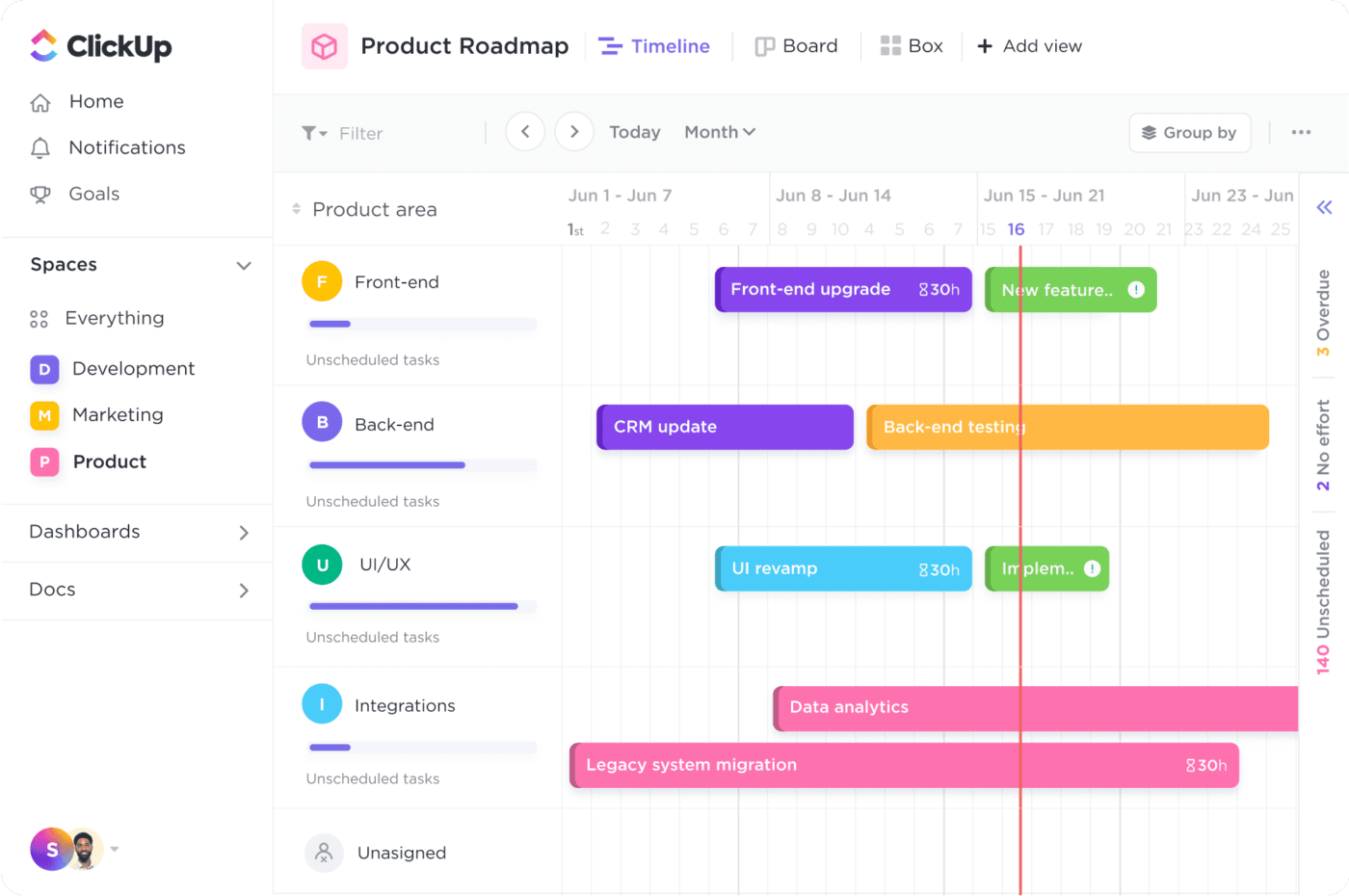
تصور خارطة طريق منتجك وإدارتها في ClickUp Timeline View
إذا كان كلا الطرفين على دراية بالخطة، يمكنك إدارة التوقعات مع الشعور بالحافز للبقاء مسؤولاً وعلى المسار الصحيح.
من خلال مشاركة خطتك ووثائق تخطيط أصحاب المصلحة، فإنك تسهل أيضاً بناء علاقة معهم. قد يكون إشراك أصحاب المصلحة أمرًا صعبًا - خاصةً إذا كانوا مشغولين - لذا فإن الانفتاح والشفافية معهم منذ البداية يمكن أن يبني الثقة ويخلق رابطة أقوى تجعل العمل معًا أسهل. 🤩
7. مراقبة خطتك وتكييفها
حتى أفضل خطط أصحاب المصلحة يمكن أن تتغير، ويجب أن تتغير خطتك في بعض الأحيان إذا كنت تقوم بإدارة أصحاب المصلحة بشكل صحيح. أثناء تنقلك خلال دورة حياة المشروع، يمكن أن تظهر تحديات وفرص جديدة - لذا من المنطقي تمامًا تغيير خطتك لتتناسب معها.
اعمل على إدارة أصحاب المصلحة وعلاقاتك معهم طوال فترة المشروع. تحقق بانتظام للتأكد من فعالية خطتك. قد تكتشف أن التحديثات التي خططت لها تحدث بشكل متكرر للغاية وتتسبب في فك ارتباط أصحاب المصلحة.
قد تكتشف أن قنوات التواصل التي اخترتها لا تتوافق مع خطة إدارة أصحاب المصلحة. راقب بشكل استباقي، حتى تتمكن من إجراء تعديلات للأفضل. ⚒️
نصائح حول خطة إدارة أصحاب المصلحة
معرفة أنك بحاجة إلى خطة وفهم أفضل طريقة لتنفيذها أمران مختلفان. اعثر على طرق لجعل خطة إدارة أصحاب المصلحة الناجحة أكثر فعالية ونجاحاً من خلال هذه النصائح الخمس المفيدة.
1. اجعل خطتك أكثر سهولة في الاستخدام
خطة إدارة أصحاب المصلحة ليست مجرد وثيقة داخلية لإرشادك فحسب، بل هي وثيقة ستشاركها مع فريق المشروع بأكمله وربما مع أصحاب المصلحة أيضًا. وهذا يعني أنها يجب أن تكون سهلة الفهم، بلغة واضحة وموجزة.
تجنب المبالغة في الصياغة التقنية التي تستخدمها، واستخدم الرسوم البيانية والجداول الزمنية والجداول والصور ذات الصلة لتفريق النص وتوفير صور مفيدة، مما يجعل التجربة أكثر سهولة في الاستخدام. ✨
2. خطط لما هو غير متوقع
لا يمكننا التخطيط لكل الاحتمالات، ولكن يمكننا توقع بعض المشاكل الأكثر احتمالاً. تأكد من أن خطتك تحتوي على عنصر إدارة المخاطر الذي يأخذ في الاعتبار العوائق والتعقيدات المحتملة - إلى جانب أفكار لكيفية التعامل معها. ⚒️
قد تخطط لإصدار تحديثات في جدول زمني محدد، ولكن التأخيرات والعوائق في المشروع تعني أن هذه التحديثات قد تتأخر. ضع في اعتبارك اللحظات التي قد يحدث فيها ذلك، وقم ببناء بعض الحشو في جدولك الزمني حتى لا تكون دائمًا متأخرًا بخطوة واحدة إذا واجهت مشكلة.
3. كن منفتحاً وشفافاً
الشفافية تبني الثقة، وهذا شيء تريد أن يثق بك أصحاب المصلحة بوفرة. كن منفتحًا وشفافًا طوال المشروع بأكمله حتى تحصل على تأييد أصحاب المصلحة الرئيسيين في المشروع ويثقون بك للقيام بأفضل ما لديك.
كن صادقًا بشأن المواعيد النهائية والجداول الزمنية والمعالم الرئيسية حتى تتمكن من إدارة التوقعات. اعترف عندما ترتكب خطأ، واعتذر عن أي تأثير قد يكون له تأثير على الآخرين. حمّل نفسك والآخرين المسؤولية، و قم بإدارة مشروعك بشفافية والثقة في الاعتبار من أجل خطة ناجحة حقًا لإدارة أصحاب المصلحة. 🤝
4. كن متاحاً لأصحاب المصلحة
على الرغم من أنك لست بحاجة إلى أن تكون متاحًا لأصحاب المصلحة في كل دقيقة من اليوم، إلا أنهم يجب أن يشعروا بأن لديهم علاقة جيدة معك ويمكنهم التواصل معك إذا كان لديهم أي أسئلة. ضع توقعاتك مبكراً حول من سيكون متاحاً لمناقشة المشروع ومتى، حتى تتمكن من إبقاء خطوط الاتصال مفتوحة ومناسبة. 📞
عيّن عضوًا في الفريق ليكون الشخص المسؤول عن كل واحد من أصحاب المصلحة الرئيسيين - أو شخصًا لكل مجموعة من أصحاب المصلحة إذا كنت تدير مشروعًا واسع النطاق. زوّد أصحاب المصلحة بتفاصيل الاتصال بعضو الفريق المسؤول، وأخبرهم بأفضل طريقة للبقاء على اتصال بين التحديثات الرسمية.
إن بناء التواصل يطمئنهم، ويمنحك طريقة أخرى لإبقائهم على اتصال من خلال خطة فعالة لإدارة أصحاب المصلحة.
5. استخدم أدوات لتسهيل إدارة أصحاب المصلحة 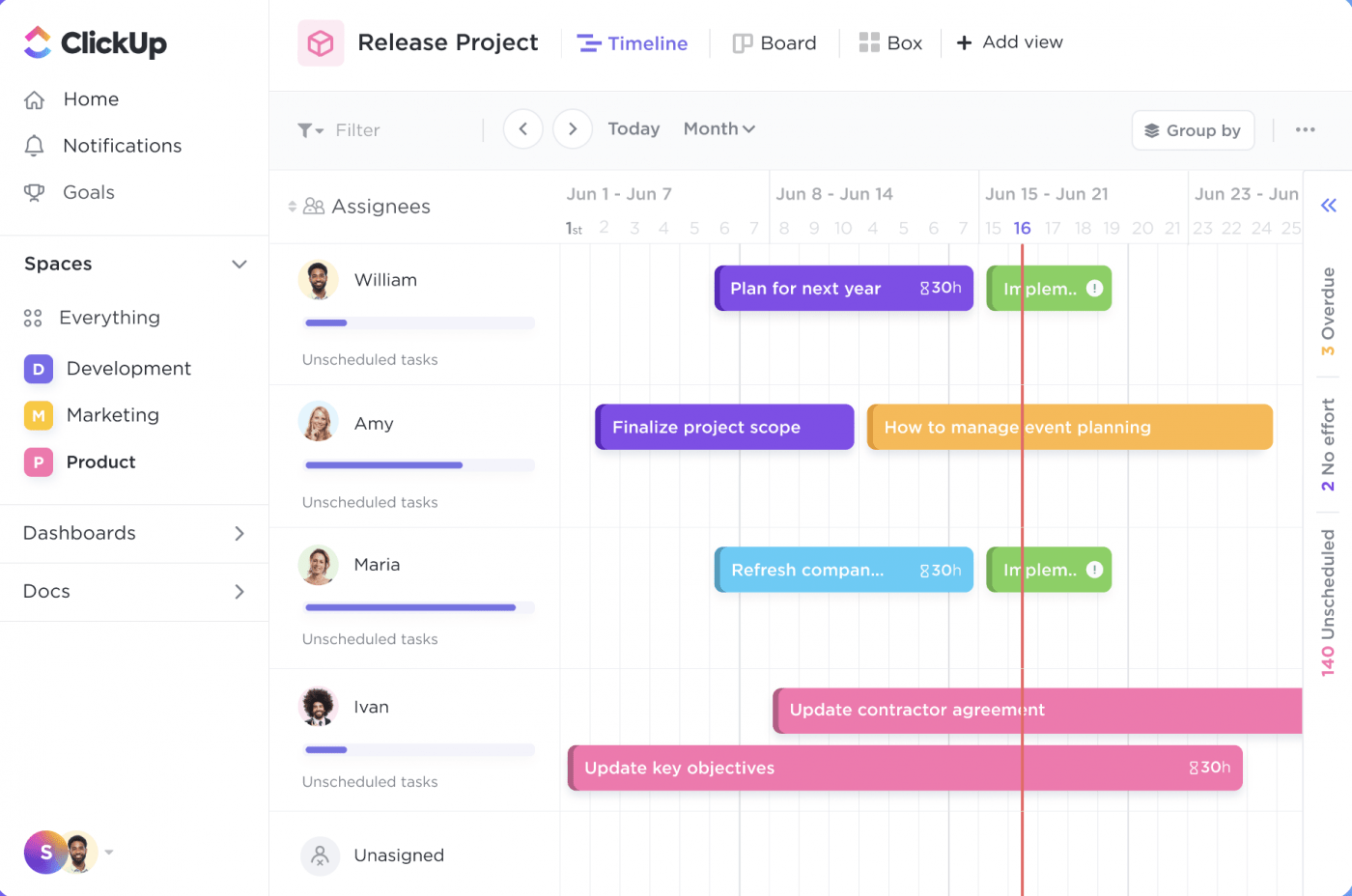
توفر طريقة عرض المخطط الزمني في ClickUp نظرة شاملة على مواردك ومهامك
قد تكون إدارة أصحاب المصلحة وبقية عملية مشروعك بدون الأدوات المناسبة تحدياً كبيراً. لحسن الحظ، قمنا ببناء أفضل برنامج إدارة المشاريع هناك-كليك أب
ClickUp هو المركز المثالي لجميع إدارة المشاريع الاحتياجات. تنظيم الأشخاص والموارد والميزانيات والمهام. إنشاء ومراقبة مخططات إدارة المشاريع والجداول الزمنية وقوائم المهام والتبعيات.
اجتمعوا لتبادل الأفكار أو حل المشكلات باستخدام السبورات البيضاء، وتعاونوا على المستندات لإنشاء وثائق المشروع للفريق بأكمله. قم بتخصيص لوحة التحكم الخاصة بك واطلع على حالة مشروعك في لحظة، مما يتيح لك العمل بشكل استباقي واستراتيجي. ✨
ابتكر نهجاً ناجحاً لإدارة أصحاب المصلحة
تعد إدارة أصحاب المصلحة أمرًا بالغ الأهمية لعملية تخطيط مشروعك - خاصةً إذا كنت تعمل على مشروع كبير أو مهم أو مشروع يمتد لفترة زمنية طويلة، أو إذا كان مشروعك يتضمن بعض العملاء ذوي الأولوية القصوى. استخدم هذه النصائح لمساعدتك على فهم العملية وبناء خطة إدارة أصحاب المصلحة التي تبقي الجميع على اطلاع من البداية إلى النهاية.
إذا كانت إدارة المشاريع الناجحة على قائمة مهامك، ففكر في استخدام ClickUp كمنصة لإدارة المشاريع. لا يحتوي ClickUp على قوالب محددة لمساعدتك في تبسيط عملية إدارة أصحاب المصلحة، ولكنه يوفر الكثير من الميزات والقوالب المدمجة للمساعدة في جميع مجالات إدارة المشاريع والإنتاجية.
اركب معنا و جرّب ClickUp اليوم مجانًا لترى كيف يمكن أن يبدو مركز الإنتاجية الجديد الخاص بك. 🤩

